Lumberton (609) 261-2223
1561 New Jersey 38, Lumberton, NJ 08048
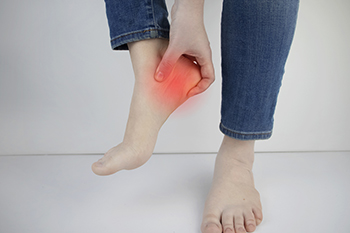
Plantar fasciitis is a painful foot condition that affects millions of people. It is also the most common form of heel pain. The plantar fascia is a fibrous band of connective tissue linking the heel bone to the toes, spanning the bottom of the foot. It supports the arch, and helps absorb shock during walking, running, and jumping. The plantar fascia can develop micro-tears and become inflamed and very painful when overstressed. This is known as plantar fasciitis. The pain of plantar fasciitis is often most severe after periods of rest, such as first thing in the morning. Plantar fasciitis may be contributed to by obesity, old age, flat feet, high arches, tight Achilles tendons, and certain physical activities that involve jumping, dancing, or running. If you have pain in your heel, see a podiatrist. They can determine if you have plantar fasciitis and treat it with a variety of methods and techniques.
Plantar fasciitis is a common foot condition that is often caused by a strain injury. If you are experiencing heel pain or symptoms of plantar fasciitis, contact one of our podiatrists from Port Richmond Family Footcare. Our doctors can provide the care you need to keep you pain-free and on your feet.
What Is Plantar Fasciitis?
Plantar fasciitis is one of the most common causes of heel pain. The plantar fascia is a ligament that connects your heel to the front of your foot. When this ligament becomes inflamed, plantar fasciitis is the result. If you have plantar fasciitis you will have a stabbing pain that usually occurs with your first steps in the morning. As the day progresses and you walk around more, this pain will start to disappear, but it will return after long periods of standing or sitting.
What Causes Plantar Fasciitis?
There are some risk factors that may make you more likely to develop plantar fasciitis compared to others. The condition most commonly affects adults between the ages of 40 and 60. It also tends to affect people who are obese because the extra pounds result in extra stress being placed on the plantar fascia.
Prevention
There are a variety of treatment options available for plantar fasciitis along with the pain that accompanies it. Additionally, physical therapy is a very important component in the treatment process. It is important that you meet with your podiatrist to determine which treatment option is best for you.
If you have any questions, please feel free to contact our office located in Lumberton, NJ, . We offer the newest diagnostic and treatment technologies for all your foot care needs.
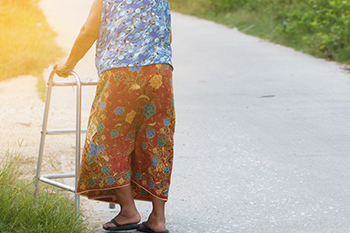
Research has shown that one of the leading causes of injury among older people is falling. It can lead to a fractured foot and other bones may break when falling occurs. As we age, our bones can become brittle and the risk of falling increases. There are preventive methods that may help to prevent falling. These can include having routine medical examinations performed which can also be useful in updating existing medication. Additionally, it is beneficial to remove worn rugs in the living area and to improve lighting in the house. Many people have installed grab bars in the shower and toilet areas as this can help to provide stability. Incorporating a gentle exercise regime as part of your daily routine can help to improve muscle strength and wearing shoes that fit correctly is instrumental in the prevention of falls. Using walkers or canes can be crucial in maintaining balance and it is important to refrain from drinking excess alcohol. Several foot conditions can result from falling so it is advised that you confer with a podiatrist who can help you with effective prevention methods.
Preventing falls among the elderly is very important. If you are older and have fallen or fear that you are prone to falling, consult with one of our podiatrists from Port Richmond Family Footcare. Our doctors will assess your condition and provide you with quality advice and care.
Every 11 seconds, an elderly American is being treated in an emergency room for a fall related injury. Falls are the leading cause of head and hip injuries for those 65 and older. Due to decreases in strength, balance, senses, and lack of awareness, elderly persons are very susceptible to falling. Thankfully, there are a number of things older persons can do to prevent falls.
How to Prevent Falls
Some effective methods that older persons can do to prevent falls include:
Falling can be a traumatic and embarrassing experience for elderly persons; this can make them less willing to leave the house, and less willing to talk to someone about their fears of falling. Doing such things, however, will increase the likelihood of tripping or losing one’s balance. Knowing the causes of falling and how to prevent them is the best way to mitigate the risk of serious injury.
If you have any questions, please feel free to contact our office located in Lumberton, NJ, . We offer the newest diagnostic and treatment technologies for all your foot care needs.
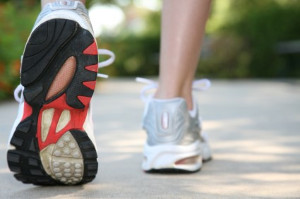
The arch of the foot functions in three major ways. First, it serves as a shock absorber when you walk, run, and jump. Second, it serves as a stabilizing factor for activities on all types of surfaces. Third, the arch of the foot helps to distribute your weight across the entire foot, rather than just on the heel or ball. As a runner, it is extremely important to find shoes that offer the necessary arch support. The needs differ according to whether you have flat feet, normal arches, or high arches. Many running shoes will accommodate someone with normal arches. Those with flat feet, however, may wish to look for shoes with a well-cushioned middle and a wider toe box. By contrast, high arches generally put more pressure on the ball of the foot causing it to roll outward. Shoes with extra cushioning and high insoles may help. In some cases, orthotics may be used to help counteract your specific condition. Custom orthotics can be made by a podiatrist. If your feet consistently hurt after a run you may wish to consult a podiatrist for an examination to determine whether the pain is related to arch problems, as well as recommendations on the best running shoes for you.
If you are a runner, wearing the right running shoe is essential. For more information, contact one of our podiatrists from Port Richmond Family Footcare. Our doctors can provide the care you need to keep you pain-free and on your feet.
Choosing the Right Running Shoe for Your Foot Type
To increase performance and avoid the risk of injury, it is important to choose the right running shoe based on your foot type. The general design of running shoes revolves around pronation, which is how the ankle rolls from outside to inside when the foot strikes the ground.
If you have any questions please feel free to contact our office located in Lumberton, NJ, . We offer the newest diagnostic and treatment technologies for all your foot and ankle needs.
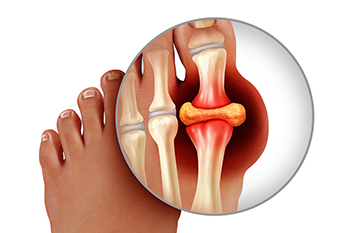
Many of the first signs that you may be experiencing a bout of gout include redness, swelling, tenderness, and pain in the big toe. While gout often attacks the first joint of the big toe, it can appear in a number of other joints throughout the body, including the ankle, knee, wrist, fingers, and elbow. It is an inflammatory arthritic condition that develops as the result of a buildup of uric acid in the blood system. Uric acid can form crystals in the joints that become inflamed and cause gout symptoms. Attacks can last hours, days, and sometimes weeks, and once you have gout, it may reappear from time to time. Ways to prevent gout include drinking plenty of water, limiting the intake of alcohol, and avoiding foods that are rich in purines. Among the foods noted for high purine levels are shellfish and organ meats, such as liver and kidneys. Maintaining a healthy body weight is another preventative measure, along with eating lots of fresh fruits and vegetables, and exercising regularly. Several medications that help reduce gout symptoms and decrease uric acid levels in the body can be prescribed by a podiatrist, who also can monitor your condition.
Gout is a painful condition that can be treated. If you are seeking treatment, contact one of our podiatrists from Port Richmond Family Footcare. Our doctors will treat your foot and ankle needs.
What Is Gout?
Gout is a form of arthritis that is characterized by sudden, severe attacks of pain, redness, and tenderness in the joints. The condition usually affects the joint at the base of the big toe. A gout attack can occur at any random time, such as the middle of the night while you are asleep.
Symptoms
Risk Factors
Prior to visiting your podiatrist to receive treatment for gout, there are a few things you should do beforehand. If you have gout you should write down your symptoms--including when they started and how often you experience them, important medical information you may have, and any questions you may have. Writing down these three things will help your podiatrist in assessing your specific situation so that he or she may provide the best route of treatment for you.
If you have any questions, please feel free to contact our office located in Lumberton, NJ, . We offer the newest diagnostic and treatment technologies for all your foot care needs.
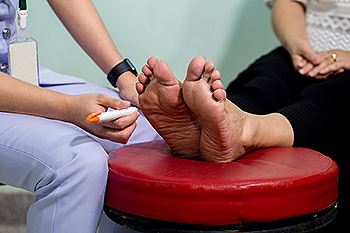
As many people seem to develop diabetes, it is wise to understand that this blood sugar-insulin imbalance can ultimately affect your feet. Foot complications are considered to be one of the major causes of hospitalizations for diabetics taking insulin and a big factor in the development of foot ulcers. One remedy for feet affected by diabetes is losing weight. Many experts in diabetic foot care also suggest a regular exercise program. And some believe that changing the way you eat, to include more fruits and vegetables, can help to reduce the onset of diabetic bouts. Improving foot health is extremely important, because foot infections can cause serious problems, including ulcers and gangrene. Further, it is important for diabetics to wear shoes that do not constrict the feet and socks that do not cut off the circulation in the ankles. It is also suggested that diabetics quit smoking, which can lead to cardiovascular and lung disease. Anyone with diabetes is wise to make regular appointments with a podiatrist who can closely monitor their foot conditions and offer treatments if or when problems arise.
Diabetic foot care is important in preventing foot ailments such as ulcers. If you are suffering from diabetes or have any other concerns about your feet, contact one of our podiatrists from Mount Holly Family Footcare. Our doctors can provide the care you need to keep you pain-free and on your feet.
Diabetic Foot Care
Diabetes affects millions of people every year. The condition can damage blood vessels in many parts of the body, especially the feet. Because of this, taking care of your feet is essential if you have diabetes, and having a podiatrist help monitor your foot health is highly recommended.
The Importance of Caring for Your Feet
Patients with diabetes should have their doctor monitor their blood levels, as blood sugar levels play such a huge role in diabetic care. Monitoring these levels on a regular basis is highly advised.
It is always best to inform your healthcare professional of any concerns you may have regarding your feet, especially for diabetic patients. Early treatment and routine foot examinations are keys to maintaining proper health, especially because severe complications can arise if proper treatment is not applied.
If you have any questions please feel free to contact our office located in Lumberton, NJ, . We offer the newest diagnostic and treatment technologies for all your foot and ankle needs.
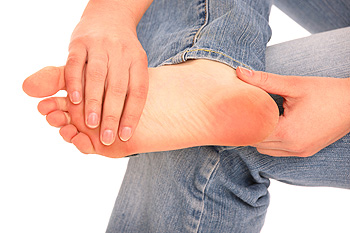
Young athletes may be prone to developing foot pain for various reasons. It may develop as a result of engaging in specific types of sporting activities that involve running and jumping. Foot injuries that happen gradually can include stress fractures and tendonitis and can produce a considerable amount of pain. Acute injuries can consist of a fracture, sprain, or bruise, and can cause severe pain and discomfort. Many people who endure this type of injury often need to have an X-ray taken, which can provide a proper diagnosis. There are methods that can be implemented which may help to prevent foot pain. These can include wearing shoes that fit correctly and replacing them approximately every three to four hundred miles. If your child has foot pain and is active in sports, please confer with a podiatrist who can recommend the correct treatment techniques.
Foot Pain
Foot pain can be extremely painful and debilitating. If you have a foot pain, consult with one of our podiatrists from Port Richmond Family Footcare. Our doctors will assess your condition and provide you with quality foot and ankle treatment.
Causes
Foot pain is a very broad condition that could be caused by one or more ailments. The most common include:
Diagnosis
To figure out the cause of foot pain, podiatrists utilize several different methods. This can range from simple visual inspections and sensation tests to X-rays and MRI scans. Prior medical history, family medical history, and any recent physical traumatic events will all be taken into consideration for a proper diagnosis.
Treatment
Treatment depends upon the cause of the foot pain. Whether it is resting, staying off the foot, or having surgery; podiatrists have a number of treatment options available for foot pain.
If you have any questions, please feel free to contact our office located in Lumberton, NJ, . We offer the newest diagnostic and treatment technologies for all your foot care needs.
Although plantar fasciitis (an inflammation of the plantar fascia ligament on the sole of the foot) is often the root of heel pain, it can come from a variety of other conditions as well. For instance, compression of the medial calcaneal nerve, which travels down the inner part of the ankle, can create a tingling or numb sensation in the heel as well as pain. In older adults, fat pads in the heel can wear down (fat pad atrophy) and cause pain. Systemic inflammatory conditions such as certain types of arthritis, Reiter syndrome, ankylosing spondylitis, and a common type of lupus (systemic lupus erythematosus) may sometimes be associated with heel pain. Sometimes tiny nodules, or plantar fibroma, develop on the plantar fascia which can cause pain in the arch near the heel. To have the cause of your heel pain properly diagnosed and treated, make an appointment with a podiatrist.
Many people suffer from bouts of heel pain. For more information, contact one of our podiatrists of Mount Holly Family Footcare. Our doctors can provide the care you need to keep you pain-free and on your feet.
Causes of Heel Pain
Heel pain is often associated with plantar fasciitis. The plantar fascia is a band of tissues that extends along the bottom of the foot. A rip or tear in this ligament can cause inflammation of the tissue.
Achilles tendonitis is another cause of heel pain. Inflammation of the Achilles tendon will cause pain from fractures and muscle tearing. Lack of flexibility is also another symptom.
Heel spurs are another cause of pain. When the tissues of the plantar fascia undergo a great deal of stress, it can lead to ligament separation from the heel bone, causing heel spurs.
Why Might Heel Pain Occur?
Treatments
Heel pain should be treated as soon as possible for immediate results. Keeping your feet in a stress-free environment will help. If you suffer from Achilles tendonitis or plantar fasciitis, applying ice will reduce the swelling. Stretching before an exercise like running will help the muscles. Using all these tips will help make heel pain a condition of the past.
If you have any questions please contact our office located in Lumberton, NJ, . We offer the newest diagnostic and treatment technologies for all your foot and ankle needs.
 The medical term for the foot condition that is known as an ingrown toenail is referred to as onychocryptosis. It occurs when the toenail grows into the skin and can cause severe pain and discomfort. It can happen as a result of trimming the toenails incorrectly, or from wearing shoes that do not fit properly. Noticeable symptoms that patients can see include redness and swelling, and there may be drainage from the injured nail. The most common toe that is affected is the big toe, and it can cause difficulty in walking. Mild relief may be found when the toe is soaked in warm water, and this may help to soften the skin. If you have an ingrown toenail, it is strongly advised that you are under the care of a podiatrist who can properly treat this condition.
The medical term for the foot condition that is known as an ingrown toenail is referred to as onychocryptosis. It occurs when the toenail grows into the skin and can cause severe pain and discomfort. It can happen as a result of trimming the toenails incorrectly, or from wearing shoes that do not fit properly. Noticeable symptoms that patients can see include redness and swelling, and there may be drainage from the injured nail. The most common toe that is affected is the big toe, and it can cause difficulty in walking. Mild relief may be found when the toe is soaked in warm water, and this may help to soften the skin. If you have an ingrown toenail, it is strongly advised that you are under the care of a podiatrist who can properly treat this condition.
Ingrown toenails can become painful if they are not treated properly. For more information about ingrown toenails, contact one of our podiatrists of Port Richmond Family Footcare. Our doctors can provide the care you need to keep you pain-free and on your feet.
Ingrown Toenails
Ingrown toenails occur when a toenail grows sideways into the bed of the nail, causing pain, swelling, and possibly infection.
Causes
Prevention
Because ingrown toenails are not something found outside of shoe-wearing cultures, going barefoot as often as possible will decrease the likeliness of developing ingrown toenails. Wearing proper fitting shoes and using proper cutting techniques will also help decrease your risk of developing ingrown toenails.
Treatment
Ingrown toenails are a very treatable foot condition. In minor cases, soaking the affected area in salt or antibacterial soaps will not only help with the ingrown nail itself, but also help prevent any infections from occurring. In more severe cases, surgery is an option. In either case, speaking to your podiatrist about this condition will help you get a better understanding of specific treatment options that are right for you.
If you have any questions please feel free to contact our office located in Lumberton, NJ, . We offer the newest diagnostic and treatment technologies for all your foot and ankle needs.